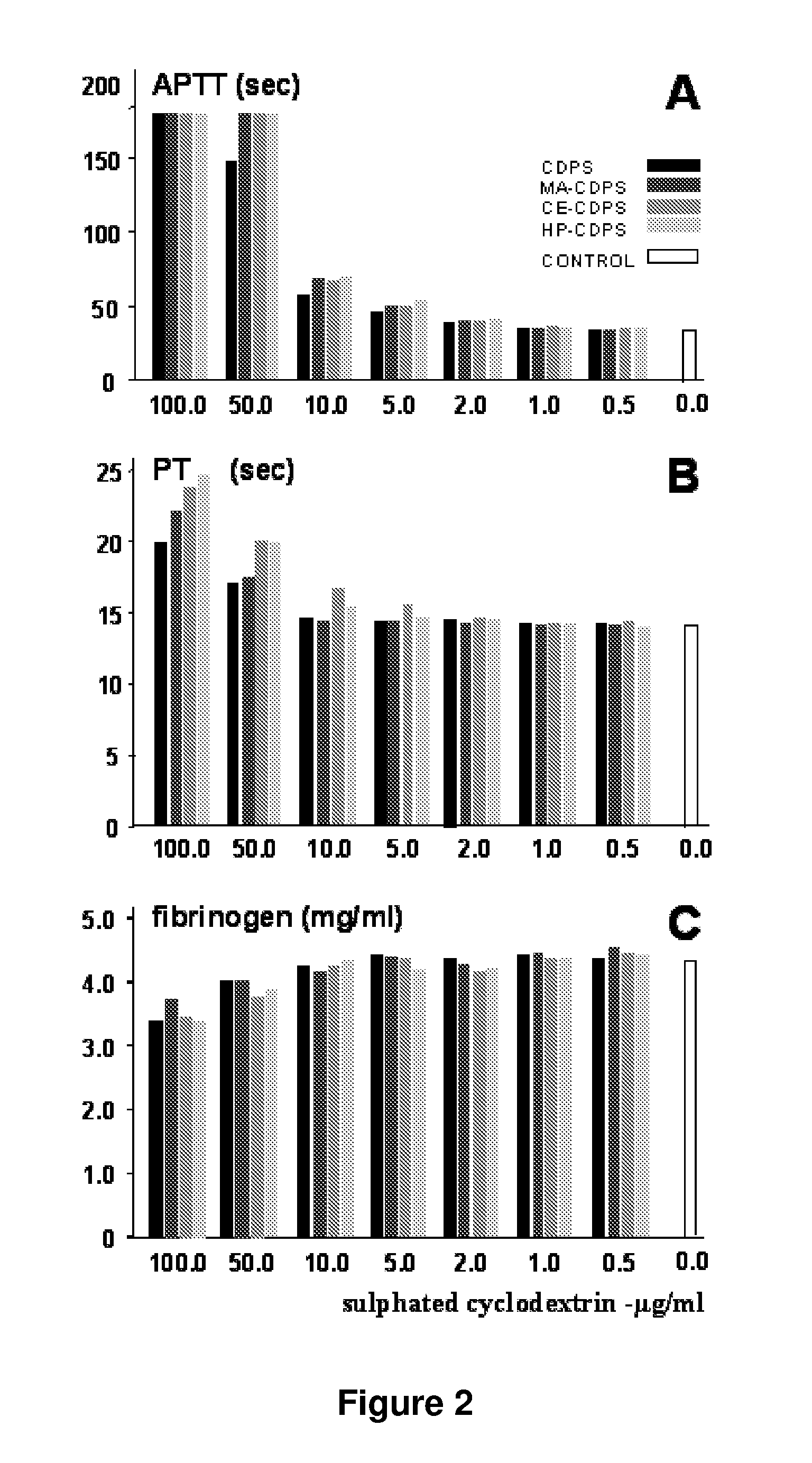Carboxyethylated Cyclodextrin Polysulfates Useful As Medicaments
a technology of cyclodextrin and carboxyethylated cyclodextrin, which is applied in the preparation of sugar derivatives, biocides, sugar derivatives, etc., can solve the problems of heparin-related thromboembolic accidents and inducing thromboembolic complications at the same time, and achieve the effect of preventing cartilage proteoglycan depletion and minimal potential to induce heparin-related
- Summary
- Abstract
- Description
- Claims
- Application Information
AI Technical Summary
Benefits of technology
Problems solved by technology
Method used
Image
Examples
example 1
OF CARBOXYETHYL-β-CYCLODEXTRIN
[0057]Pyridine sulfonate (sulfur trioxide pyridine complex) was heated in a water bath to 70-80° C. Pyridine sulfonate (1000 mL) was added to a mechanically stirred vessel with a side arm, and maintained at 80° C. with a water bath. A carboxyethyl-β-cyclodextrin with a degree of substitution of 3 (100 g) from Cyclolab Ltd. (Hungary) was added slowly with rapid stirring. The mixture was maintained at 80° C. with stirring for 2.5 hours, then water (500 mL) was added.
example 2
ON OF THE SODIUM SALT OF CARBOXYETHYL-β-CYCLODEXTRIN SULFATE
[0058]The reaction mixture resulting from example 1 was poured with rapid stirring into methanol (7500 mL) containing sodium acetate (750 g). The precipitate was isolated by filtration using a Buchner funnel, washed with methanol (2000 mL), air dried, then dried under vacuum. The precipitate (sodium salt of carboxyethyl-β-cyclodextrin sulfate) was then dissolved in water (1000 mL), and the resulting aqueous solution was analyzed for free sulfate content, and BaCl2 dissolved in hot water was added to precipitate barium sulfate. The precipitate was allowed to settle, then removed by centrifugation.
[0059]Five volumes of methanol was added to the supernatant to precipitate the product and this was isolated by Buchner funnel, washed with methanol and dried under vacuum.
example 3
CHARCOAL TREATMENT OF A CARBOXYETHYL CYCLODEXTRIN POLYSULFATE SODIUM SALT
[0060]2-carboxyethyl-8-cyclodextrin polysulfate sodium salt (hereinafter referred as CE-CDPS) from example 2 was dissolved at the rate of 300 mg / mL in water. Activated charcoal (10 g) was added for each 100 g of the cyclodextrin polysulfate sodium salt. The mixture was stirred for 30 minutes at room temperature, and filtered several times to remove charcoal including the use of a final 0.2 μm filter membrane. The filtered cyclodextrin compound solution was slowly added into five volumes of stirred methanol. The mixture was stirred for 10 minutes. The resulting product was isolated by filtration, washed with methanol, and dried under vacuum. Its elemental analysis data are provided in table 1.
PUM
| Property | Measurement | Unit |
|---|---|---|
| Temperature | aaaaa | aaaaa |
| Temperature | aaaaa | aaaaa |
| Temperature | aaaaa | aaaaa |
Abstract
Description
Claims
Application Information
 Login to View More
Login to View More - R&D
- Intellectual Property
- Life Sciences
- Materials
- Tech Scout
- Unparalleled Data Quality
- Higher Quality Content
- 60% Fewer Hallucinations
Browse by: Latest US Patents, China's latest patents, Technical Efficacy Thesaurus, Application Domain, Technology Topic, Popular Technical Reports.
© 2025 PatSnap. All rights reserved.Legal|Privacy policy|Modern Slavery Act Transparency Statement|Sitemap|About US| Contact US: help@patsnap.com



